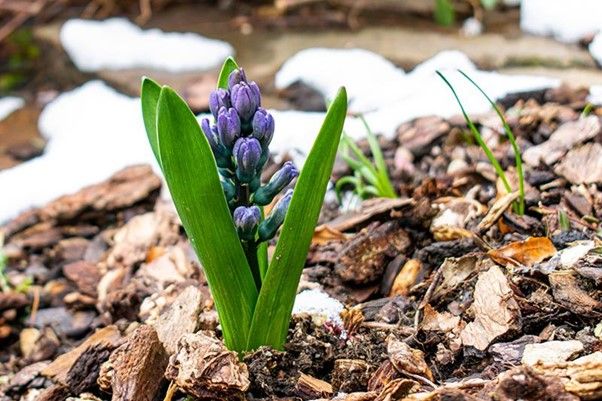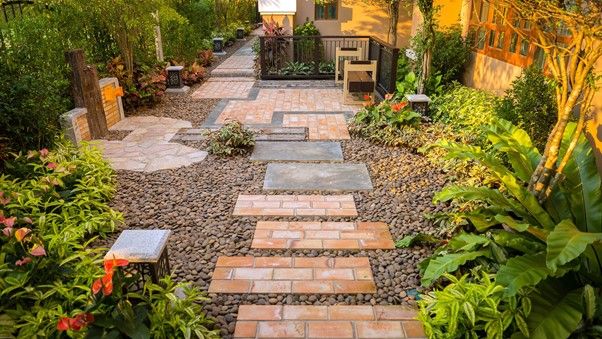Low Water Landscaping Ideas | Xeriscaping Guide for the Okanagan Valley, British Columbia

A beautiful landscape is an asset to every homeowner; landscapes contribute to our well being, make us feel connected to nature, and add serious curb appeal to properties.
In hot and dry areas like Kelowna, BC, Canada, embracing low water landscaping can help you reduce your home’s environmental footprint and let you enjoy low maintenance outdoor spaces.
What is a Low Water Landscape?
Low water landscaping - also known as xeriscaping or low irrigation landscaping - refers to landscaping practices that require little or no water and use drought tolerant plants that are native to the local area.
Low water landscapes are often encouraged by municipalities to conserve water and help to prevent invasive plant species from spreading.
The Benefits of Low Water Landscaping
There are a number of benefits to installing low water plants and irrigation systems for your outdoor spaces.
- Help the environment by reducing water and energy use
- Promote growth of non-invasive native plants
- Plants with deep roots prevent erosion and are good at retaining moisture
- Add curb appeal for environmentally-minded buyers
- Save money on energy and water bills
- Spend less time doing yard maintenance
Why Low Water Landscaping is Important for the Okanagan, British Columbia
Due to our hot and dry summer climate in BC, Canada - which only appears to be getting hotter every year - some plants just don’t work here, while others use too much water to make good environmental sense.
And with the average summer temperature of ~28C in Kelowna, it’s just not pleasant to spend your summer days working in the hot outdoor space.
How to Landscape Without Water - An Introduction to DIY Low Water Landscaping
There are 4 basic steps to installing a successful low water landscape:
- Create different hydrozones in your yard
- Consider hardscaping for certain sections of your yard
- Select low water use plants
- Irrigate your lawn and landscape
- Add mulch
Step 1) Design Hydrozones & Hardscaping
Hydrozones are different planting areas where plants with similar water needs are grouped together.
Using hydrozones lets you keep a variety of different plants and flowers while making efficient use of water.
Hydrozones are usually separated into 3 categories based on their water use: low, medium, and high. When you design your hydrozones, take into consideration how much wind, sun, shade, and moisture each area of your yard gets naturally.
Step 2) Hardscaping
Hardscaping refers to using man-made, non-living structures in landscape design for decorative or practical uses.
Combine low water use plants with hardscaping components to create a low maintenance yard that uses less water without having to sacrifice curb appeal. Hardscape components include:
- Gravel
- Decomposed granite
- Pavement
- Stones & large boulders
- Wood elements like decks, pergolas, and gazebos
Step 3) Get Drought Tolerant & Low Water Use Plants
This section shows you some of our favorite low-water plants for gardens and house landscapes in the Okanagan Valley, British Columbia.
Adding plants to your yard looks great, cools down your yard, and provides a back-yard habitat for birds, bees, butterflies, and ladybugs.
You can pick up plants at a local garden store, get out your gloves and do it yourself, or hire a great Kelowna landscaping company to do the dirty work.
Annual Garden Plants
Annuals are flowering plants that bloom, seed, and die within the same year they are planted. Planting annuals lets you experiment with different themes for your garden from year to year and create bright, attractive garden displays.
Plants for low maintenance flower beds:
- Geranium
- Herbs like Oregano, Parsley, Sage, Rosemary, and Thyme
- Lantana
- Marigold (difficult to get rid of)
- Moss Rose
- Petunia
- Strawflower
- Sunflower
- Verbena
- Zinnia
Low Water Perennials
Perennials are plants that live for more than 2 or 3 growing seasons. Perennials include flowering plants, cacti, shrubs, and trees.
Here are some of our favorite Low water perennials for the Okanagan:
- Blue Flax
- Cape Fuchsia (African Queen)
- Crocosmia (Coppertips)
- Cushion Spurge
- Daylilies
- German Iris
- Echinacea (Coneflower)
- Eryngium (Sea Holly)
- Herbs like Oregano, Parsley, Sage, Rosemary, and Thyme
- Lavender
- Periwinkle
- Rose Campion
- Santolina
- Verbena
- Yarrow
These are some favorite felty leaved plants with blue, purple, gray or silver foliage
- Russian Sage
- Salvia Caradonna
- Woolly Thyme
Low Water Ground Cover Plants
Ground cover refers to low-lying perennial plants that grow over an area of land and usually require little maintenance. Over time, ground cover forms helpful mats that keep the soil cool and shaded from the sun.
- Alumroot
- Barrenwort
- Blue Fescue Grass
- Boston Ivy
- BroadLeaf Sedum / Stonecrop
- Catnip
- Golden Alyssum
- Hardy Ice Plant (Yellow, Starburst)
- Sage (Russian Sage, Herbal Sage)
- Sea Thrift
- Soapweed
- Thyme
- Wild Strawberry
- Wooly Sunflower
- Wormwood
- Yarrow
Drought Tolerant Succulents
Succulents are drought-tolerant plants that store water in leaves that are usually thick and fleshy.
With cool geometric patterns and gorgeous colors, drought tolerant succulents make a great focal plant in landscape designs. If you’re worried about pets or children stepping on cacti spikes, consider a potted succulent display that’s raised off of the ground.
- Dudleya
- Echeveria
- Euphorbia
- Graptopetalum
- Haworthia
- Prickly Pear Cactus
- Senecio
Low Water Ornamental Grasses
Ornamental grasses are low maintenance plants that are often resistant to both heat and cold. Grasses cool your yard and add texture to your yard’s aesthetic.
- Blue gramma / blue grama
- Blue oat grass
- Feather reed grass
- Giant feather grass
- Big bluestem
- Blue sedge
- Blue hair grass
- Blue moor grass
- Chinese silver grass
Shrubs
Shrubs, also known as bushes, are perennial woody plants that grow to be under 6 to 10 meters with dense, green leaves that create privacy in your backyard and provide shelter for wild birds.
Shrubs also improve the local air quality by filtering out pollutants and releasing tons of oxygen. With strong plant roots, they also help to hold the earth together, preventing soil erosion in your yard.
- Low water shrubs for the Okanagan:
- Common lilac
- Dwarf arctic willow
- Gold coast juniper
- Hedge cotoneaster
- Juniper skyrocket
- Oregon grape
- Red currant
- Saskatoon serviceberry plant
- Spruce: baby blue, little gem
- Winter creeper
Low Water Trees
Trees are tall, woody perennial plants with a structure consisting of roots, a trunk and branches. Spending time around trees is proven to help you feel less stressed and is also associated with better heart health.
Low water use trees for the Okanagan Valley:
- Common Hackberry Tree
- Golden Raintree
- Horsechestnut
- Kentucky Coffee Tree
- Oak (Red, Bur, and Scarlet)
- Ponderosa Pine - one of the most common naturally occurring trees in the Okanagan Valley, BC
- Smooth Sumac
Fruit Trees
Apple, apricot, cherry, fig, peach, pear, and prune plum trees all grow well in the Okanagan’s hot & dry summer weather, plus they make great use of water by producing fruit you can make into preserves, jams, and pie filling. Most fruit trees require regular spraying to keep pests at bay. For example, plum and apple trees will require moth control.
Low Water Vegetable Gardening
Low water vegetable gardening involves planting species with roots that grow deep into the soil to counter hot and dry conditions.
Low water vegetables:
- Asparagus (once roots mature)
- Beets
- Broccoli
- Cabbages
- Chives
- Eggplant
- Legumes (peas, lentils, beans)
- Okra
- Peppers
- Rhubarb
- Sweet Potato
- Swiss chard
Step 4) Install a Low Water Irrigation System
The best low water irrigation systems combine low flow sprinklers and drip lines that automatically deliver water at the right time of the morning.
Low flow irrigation systems slowly deliver water into the soil at the ground level, which has two advantages. Being low to the ground minimizes air evaporation and the slow delivery gives dry soil enough time to absorb water.
Irrigation installation and maintenance is best done by an experienced landscaping professional.

Step 5) Add Mulch
Mulch is material that is layered on top of soil to retain moisture (meaning you’ll use less water), keep the soil cool, stop weeds from growing, and hide your irrigation drip lines.
Here are some great mulches for your low water garden or landscape:
- Bark (pine or cedar)
- Sand
- Crushed rock (full of gorgeous quartz in Kelowna)
- Natural stone, also referred to as river rock
Tip: To prevent weeds from growing up through your ground cover, lay down ground sheets before spreading the material.

Low Water Landscaping Ideas for Your Home in Kelowna, BC
Front yard
- Combine varying shades of grasses and succulents for a gorgeous low-water look
- Downsize your lawn space to lower the amount of water you use
- Add a dry stream with river rocks to direct the flow of water and provide a natural look to your front yard
Back yard
- Gravel courtyard with a firepit
- Terraced rock wall with planting beds
- Potted succulent display as a focal point
- A pergola or gazebo to add shade to your garden
Side yard
- Brick, paved, or stone path with surrounding ground cover that’s soft underfoot
- Artificial turf or golf putting green
- Planter boxes with low-light species and felty leafed plants
- Landscape waste and garbage enclosure
Low Irrigation Landscaping FAQs
What plants use the most water?
Certain plants absorb far more water from the soil than others. If you live in an environment with heavy rainfall like Vancouver, BC, thirstier plants like day lilies can assist with drainage and prevent rainwater from pooling in your yard. But if you live in an arid environment, you’d be wise to avoid planting these water hog plants:
- Shrub and high hedge species like boxwoods and dogwoods
- Ferns and related plants
- Most fir trees
- Red maple
When is the best time of day to water plants to save water?
The best time of day to water plants is between sunrise and around 8 to 10am when the air and soil are still cool.
Since plants absorb the most water during daylight hours while photosynthesis is taking place, the early morning is the ideal and most efficient time of day to water your plants.
Due to moisture evaporation, you should avoid watering plants during the midday heat - especially during summer when Kelowna stays hot between 10am to 7pm. To prevent fungal growth, you should avoid watering most plants overnight.
How do I landscape my front yard for low maintenance?
- Install automatic drip irrigation
- Use slow-release garden and plant food so you’re fertilizing less often
- Plant slow-growing plants and bushes that shed leaves and foliage less often
- Plant grass alternatives like clover, creeping herbs, sedges, or other ground covering
- Embrace hardscaping and consider using artificial turf
Are there any water use restrictions in the City of Kelowna?
Yes - visit the City of Kelowna’s Water Restrictions page for details on which days of the week and times of day are OK to water your garden.
Who are the best landscaping companies in Kelowna?
Kelowna is home to more than a dozen great landscaping companies and landscape architects. We’ve rounded up our favorite landscaping companies on our luxury blog.


